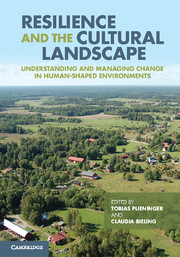 Resilience and the Cultural Landscape
Resilience and the Cultural Landscape Published online by Cambridge University Press: 05 November 2012
Introduction
Traditionally, numerous studies that analysed the impact of human activities on ecosystems conceptualised humans either as external drivers of ecosystems (albeit not influenced by them) or as users of the environment (but not influencing it). However, in recent years, studies have changed their focus on the interdependency between social systems and ecosystems (Gunderson & Holling, 2002; Holling, 2001). In this sense, Farina (2000) highlights cultural landscapes as human land use systems shaped by the intricate relationship between social and ecological systems. They are the result of a slow co-evolution of both systems and they have taken centuries to reach their current configuration, reflecting a mutual adaptation of abiotic, biotic and cultural factors.
Here, we argue that complexity theory offers new opportunities for conceptual and theoretical development when cultural landscapes are considered as complex adaptive social–ecological systems (Liu et al., 2007; Rescia et al., 2010; Walker et al., 2004). Complex adaptive systems are characterised by cross-scale non-linear interactions and feedback loops between the ecological and socioeconomic components and they present stable dynamics characterised by three complementary attributes: resilience, transformability and adaptability (Walker et al., 2004). In many studies, the concept of resilience has been seen as the capacity to withstand or recover from disturbance, while still essentially retaining the same function, structure, identity and interconnections (Walker et al., 2004). In cultural landscapes, resilience is considered as the capacity for transformation and adaptation of the population and their activities (i.e. land use system) and ecosystems in the face of gradual changes in socioeconomic conditions and biophysical characteristics, until these cross certain thresholds (Berkes & Folke, 1998; Holling, 2001). In a normative sense, resilience of cultural landscapes ensures the flows of services they supply, such as cultural identity, heritage value, recreation and tourism, land use diversity, biodiversity and carbon sequestration (Oteros-Rozas et al., Chapter 14).
To save this book to your Kindle, first ensure [email protected] is added to your Approved Personal Document E-mail List under your Personal Document Settings on the Manage Your Content and Devices page of your Amazon account. Then enter the ‘name’ part of your Kindle email address below. Find out more about saving to your Kindle.
Note you can select to save to either the @free.kindle.com or @kindle.com variations. ‘@free.kindle.com’ emails are free but can only be saved to your device when it is connected to wi-fi. ‘@kindle.com’ emails can be delivered even when you are not connected to wi-fi, but note that service fees apply.
Find out more about the Kindle Personal Document Service.
To save content items to your account, please confirm that you agree to abide by our usage policies. If this is the first time you use this feature, you will be asked to authorise Cambridge Core to connect with your account. Find out more about saving content to Dropbox.
To save content items to your account, please confirm that you agree to abide by our usage policies. If this is the first time you use this feature, you will be asked to authorise Cambridge Core to connect with your account. Find out more about saving content to Google Drive.